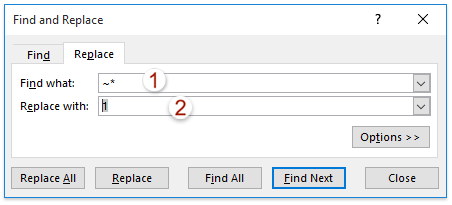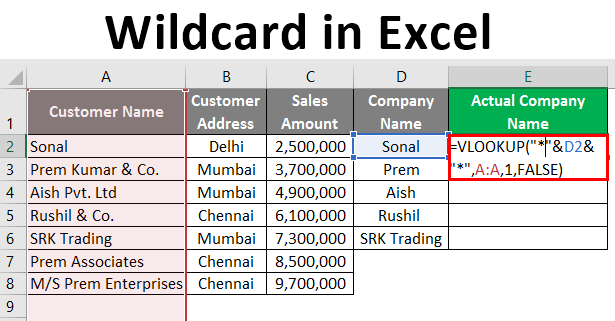
You can also use the question mark (?) wildcard to replace a single character in a search. You can also search for any name beginning with K ( K*) or ending with N ( n*). Using the asterisk wildcard, you can search by his first name only ( Kevin*), or by his last name ( *Ashton). Assuming you want to look up an employee name (Kevin Ashton) to retrieve his salary. Nothing could be more flexible.Ĭonsider the following table for example. In the same way, you can search for any cell that contains a particular word string. With this tool, you can use VLOOKUP to search for any part of a cell’s content.įor instance, you can search for any value that begins or ends with a particular letter or string. With the VLOOKUP wildcard, your searching capabilities can exceed that of Google. What if you are not so sure of the exact value you are searching for? Does that mean VLOOKUP cannot find a partial text match? Far from that. This function is so sensitive that it can detect even trailing and leading spaces in a cell – something the human eye can barely see. This doesn’t match “only” (which has two characters after the “on”) or “eon” (which has no characters after the “on”).If you are reading this, I guess you already know how the VLOOKUP function works. This matches words such as “alone”, “bone", “one” and “none". “*a?” matches any expression that contains the character “a” followed by any other single character, such as “That”, “Cap” and “Irregular”.ĬOUNTIF(B2:E7,“*on?”) returns a count of the number of cells in the range B2:E7 that contain a value that starts with any number of characters (including none) followed by “on” and then a single character. The wildcard characters (? * ~) can be used together in expressions that allow conditions. Use multiple wildcard characters in a condition

SEARCH(“~?”,B2) returns 19 if cell B2 contains “That is a question? Yes it is!” since the question mark is the 19th character in the string. “~?” matches the question mark, instead of using the question mark to match any single character.ĬOUNTIF(E,“~*”) returns a count of the number of cells in column E that contain the asterisk character.

Some examples of using the character ~ in matching patterns are: The ~ character is used to specify that the following character should be matched rather than used as a wildcard, in an expression that allows conditions. “*ed” matches a string of any length ending with “ed”, such as “Ted” or “Treed”.ĬOUNTIF(B2:E7,“*it”) returns a count of the number of cells in the range B2:E7 that contain a value that ends with “it” such as “bit” and “mit”. Some examples of the use of the wildcard character * in matching patterns are: The * character is used to match any number of characters, including none, in an expression that allows conditions. Use a wildcard to match any number of characters “Th?” matches any string beginning with “Th” and containing exactly two additional characters, such as “Then” and “That”.ĬOUNTIF(B2:E7,“?ip”) returns a count of the number of cells in the range B2:E7 that contain a value that starts with a character followed by “ip”, such as “rip” and “tip”. “Ea?” matches any string beginning with “Ea” and containing exactly one additional character, such as “Ea2” or “Eac”. Some examples of the use of the wildcard character ? in matching patterns are: The ? character is used to match a single character in an expression that allows conditions. Use a wildcard to match any single character


“Abc”&A1 returns “Abc2” if cell A1 contains 2.Ī1&A2 returns “12” if cell A1 contains 1 and cell A2 contains 2.ī2&”, “&E2 returns “Last, First” if B2 contains “Last” and E2 contains “First”. Some examples of the use of the concatenation operator are: The & character is used to concatenate, or join, two or more strings or the contents of referenced cells. Wildcards (*,?,~) can be used in conditions to represent one or more characters.Ĭoncatenate strings or the contents of cells The string operator (&) can be used in formulas to concatenate, or join, two or more strings or the contents of referenced cells. Use string operators and wildcards in Numbers on iPad


 0 kommentar(er)
0 kommentar(er)
